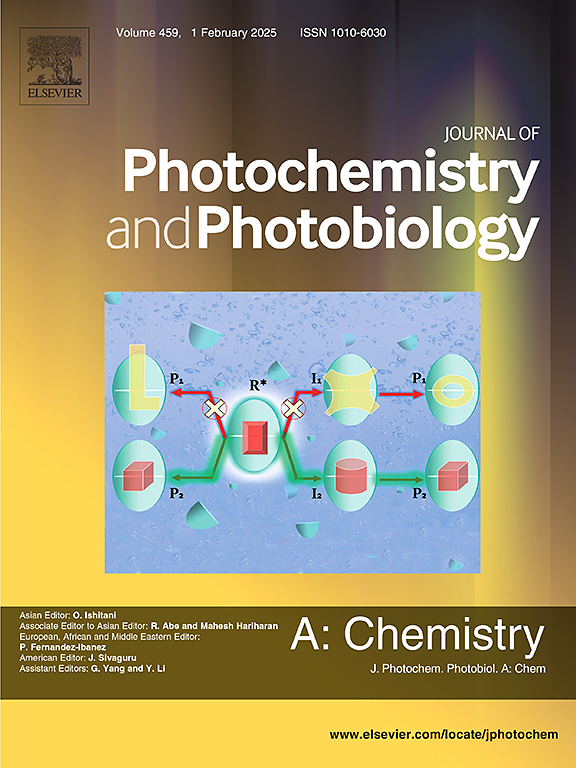Fluorescence anisotropy (FA) of anionic dyes bound to ionic and zwitterionic micelles
IF 4.1
3区 化学
Q2 CHEMISTRY, PHYSICAL
Journal of Photochemistry and Photobiology A-chemistry
Pub Date : 2025-03-19
DOI:10.1016/j.jphotochem.2025.116401
引用次数: 0
Abstract
Anionic fluorescein and 8-hydroxy-1,3,6-pyrenetrisulfonate (POH), bind to cationic and zwitterionic micelles, experience hindered rotation and exhibit fluorescence anisotropy (FA). Fluorescein emits three lines from its dianion, carboxylate, and phenolate forms. POH emissions are from excited POH* and its deprotonated form, PO−. Fluorescence was excited by vertically polarized (V) light. Spectra recorded with vertical (IVV) and horizontal (IVH) polarizers in the emitted beam were corrected for instrument response and polarization bias. Corrected line shapes were fit to Gaussians availing the computationally derived second harmonic for better fit precision. FA of the individual forms of the same dye was calculated from the IVV and IVH intensities of each component line. For fluorescein, FA phenolate > carboxylate > dianion and FA PO− > POH*. Micelle-bound dye conformations, consistent with this order, are presented. Distinguishing between FA of different forms is novel and significant to elucidation of dye-host interactions.

求助全文
约1分钟内获得全文
求助全文
来源期刊
CiteScore
7.90
自引率
7.00%
发文量
580
审稿时长
48 days
期刊介绍:
JPPA publishes the results of fundamental studies on all aspects of chemical phenomena induced by interactions between light and molecules/matter of all kinds.
All systems capable of being described at the molecular or integrated multimolecular level are appropriate for the journal. This includes all molecular chemical species as well as biomolecular, supramolecular, polymer and other macromolecular systems, as well as solid state photochemistry. In addition, the journal publishes studies of semiconductor and other photoactive organic and inorganic materials, photocatalysis (organic, inorganic, supramolecular and superconductor).
The scope includes condensed and gas phase photochemistry, as well as synchrotron radiation chemistry. A broad range of processes and techniques in photochemistry are covered such as light induced energy, electron and proton transfer; nonlinear photochemical behavior; mechanistic investigation of photochemical reactions and identification of the products of photochemical reactions; quantum yield determinations and measurements of rate constants for primary and secondary photochemical processes; steady-state and time-resolved emission, ultrafast spectroscopic methods, single molecule spectroscopy, time resolved X-ray diffraction, luminescence microscopy, and scattering spectroscopy applied to photochemistry. Papers in emerging and applied areas such as luminescent sensors, electroluminescence, solar energy conversion, atmospheric photochemistry, environmental remediation, and related photocatalytic chemistry are also welcome.

 求助内容:
求助内容: 应助结果提醒方式:
应助结果提醒方式:


